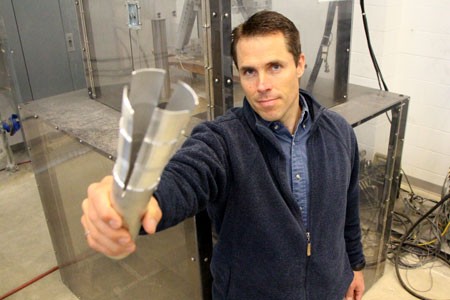
Whether you’re driving a tank through a war zone or a minivan to the grocery store, you want the assurance of knowing your vehicle was designed to withstand any kind of collision, no matter how severe.
Most vehicles are designed with crumple zones to absorb the energy from a crash while protecting the occupants inside, but in many cases, that energy spreads through the car’s infrastructure in uneven and unpredictable ways. That means vehicles don’t often crumple the way they’re supposed to, which makes it difficult for manufacturers to design a car that will react exactly the way they intended.
Bill Altenhof has an innovative new solution to that problem.
“It’s a novel way of dissipating energy,” the engineering professor says of the axial cutting device he helped develop and patent.
The concept is simple: a steel wheel-shaped device with four spoke-like blades, the device could be built in to the end of a tubular aluminum frame. Upon impact, the device would cut down into the frame, and rather than crumpling unevenly, it would split the frame, causing it to spread out slightly, almost like peels on a banana.
“Basically, it mitigates the chaos in the system,” said Dr. Altenhof, who along with colleagues Shun Yi Jin, Amitabha Majumder, and Zhanbiao Li, published the results of a number of tests he conducted on the device in a paper in the International Journal of Impact Engineering.
“There’s a degree of chaos that can influence the deformation when impact occurs,” he continued. “When the impact load varies, it carries the energy to other parts of the vehicle that it may not be supposed to go. That’s trouble. That’s how people can get contact-related injuries. You don’t want a lot of deformation near the occupant zones. But this device reduces variation, keeps the deformation resulting from an impact more consistent, and ensures that the system does what it should.”
Altenhof said the device – and the test results demonstrating exactly how the tube splits – could be used by vehicle designers to more accurately predict how a car will absorb impact energy and therefore, design it accordingly to better protect the occupants.
And while vehicular applications immediately spring to mind as an obvious use for the device, Altenhof said it could even be employed by architects designing buildings that need to withstand destruction caused by earthquakes.
“Give me any application where you need a way to optimize energy dissipation and load transfer resulting from impact or other traumatic events, and we can probably find a way to make this work,” he said.
Watch a slow-motion video of an axial cutting device slicing through an aluminium tubular frame.
